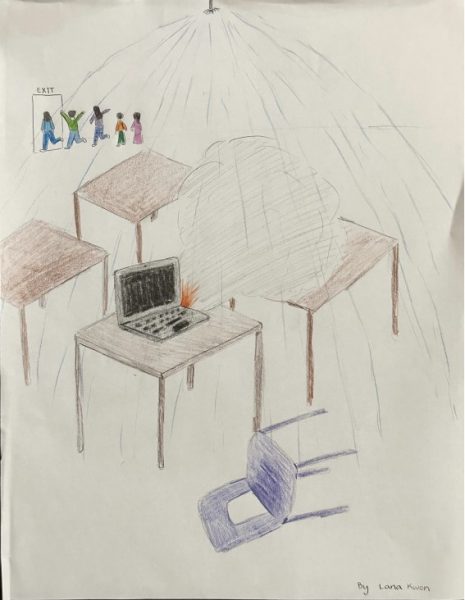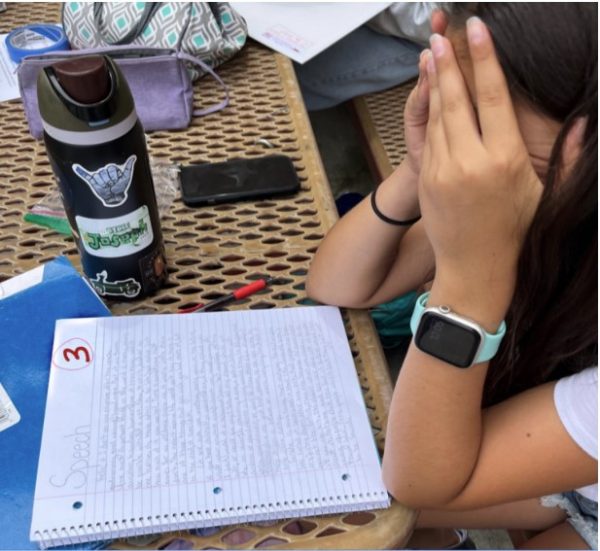A Shift to Tutorial at the End of the Day Renders It Inefficient
The change in the Woodbridge High schedule has moved tutorial from after first period to after fifth or sixth period, causing it to no longer serve its original intention
Do we really want students to be sleeping during tutorial?
We all relate to this. Stepping into a classroom after your last period of day, completely exhausted from listening to a lecture for a whole hour and thirty minutes. All you want to do is escape these school walls. But you know you can’t. Instead, you take out your ID card and stand in a long line of half awake teenagers all thinking the same thing.
Some students at Woodbridge High, including myself, were shocked this year to discover that tutorial, which was originally after first period on Tuesday through Thursday, was now at the end of the day.
Tutorial is useful because it is time to make up or retake tests and quizzes, get help from teachers, complete homework, meet up with other students to work on group projects and find information on mental health and college. But the change in the new schedule has many students upset.
Valerie Inamdar, a junior at Woodbridge High is one of those students. “This year’s schedule makes it very hard to do any work at the end of the school day,” Inamdar said.
At this point, tutorial has become an unnecessary obstacle. A classroom at tutorial is almost always full students doing everything except what they are supposed to be doing. We see those talking to their friends. Some are on their computers playing games. Others have their heads on the desk with their eyes closed. From observation, only a small percentage are actually doing work. Why is this?
Tracy Walla, a science teacher at Woodbridge High, has taken note of these actions over the past few months. “Ideally, everyone would be using tutorial as it is designed, however, I also think some students are tired at that point of the day,” Walla said.
According to the Nationwide Children’s Hospital, teens usually get around 7 to 7.5 hours of sleep every night when they should be getting 9.25 hours. Of course, many people get much less than this. We go through about six hours of school everyday and at the end of the school day, we have to go to tutorial. Great! You can sleep there right? Well yes, but that’s not what tutorial is for. Might as well just let students out thirty minutes earlier then. Tutorial is not meant to be a sleeping period. It is meant for students to get extra assistance on their assignments.
Especially for students at Woodbridge High, a highly academic performing school, students are getting a lot of pressure to succeed and compete in the system. In addition to media overloads from apps like Instagram and TikTok, students are participating in sports, clubs and other extracurriculars needed to look impressive on college applications. This produces extremely stressed teenagers. One way Woodbridge High has tried to relieve that stress is by creating a tutorial period. But if students are too tired from the entire day to do anything productive, then the tutorial period has become useless.
When tutorial was after first period, it was much more useful. Students were more awake and ready to go to the classrooms they needed help in.
Austin Sakai, a junior at Woodbridge High, explains why. “I liked tutorial last year better because you could get in last second studying before tests,” Sakai said. In other words, students had a reason to use tutorial. But now they don’t. Or at least they don’t have that drive to use it anymore.
If it was so great last year, then why was the tutorial schedule changed? There may be a few reasons.
“I believe the change was an effort to reduce the number of students missing regular class due to sports games,” Walla said.
Some students agree. “I have left class for early games and I had to ask friends or the teacher of the class I left about the work I missed,” Sakai, who plays soccer for Woodbridge, said. Last year, if a student had games in the afternoon, especially for away games, they had to leave class early. So by having tutorial at the end of the day, they would skip tutorial instead of losing class time.
Of course this may seem like a great accommodation for the athletes of Woodbridge High. As an athlete myself, I can appreciate the thought put into this. Last year, I played soccer (a winter sport) and ran track (a spring sport) so I understand the effects of missing class. However, the teachers last year were usually very considerate and being able to catch up wasn’t as big of a burden as it seems.
Plus, now that tutorial is at the end of the day, athletes who have games in the afternoon can’t go to tutorial so they do not have access to extra help from teachers or other resources such as the mental health days in the old theater.
What if an athlete needs time to study because they won’t be home until nighttime? What if they need help from their teacher for a test the next day? What if they need to attend a mandatory tutorial to make up a quiz? Athletes might not go to tutorial like the other students do. All three classes would have already happened that day, so students could go back to that classroom for help or do all of the assigned homework. But most of us are too tired to actually do any homework. By the end of the school day, most of us want to go home or do our after school extracurriculars.
According to Edficiency, tutorial began in the 1960s and soon enough fifteen percent of schools in the US were using the “Flex Model.” This is what the idea of tutorial was based on. It was originally a schedule where students had flexibility to go study in whichever class they wanted, so their schedule looked different every week.
However, due to a large amount of unstructured time, lack of organization and no training for teachers to adapt to this new model, the flex model lost popularity. The downfall of the Flex Model was due to lack of structure. It later came back in a new way to what is now called Flex period. Or what students at Woodbridge High call it, tutorial.
The original intention of tutorial was to give students additional support by giving a free period for students to ask their teachers questions. But it seems that we are hitting a wall. Once again, tutorial is no longer accomplishing its purpose. Woodbridge High has missed this opportunity for their students by allotting tutorial time to the end of the day instead of after first period like it had been last year. Like Sakai and Inamdar expressed, this is not an uncommon opinion among the students at Woodbridge High either.
Woodbridge High’s inconsistency with the benefits of tutorial needs to be addressed. But for now, we must be flexible with the current schedule by using tutorial as a way to catch up on some work or seek out resources. “Either way it depends on how wisely one uses tutorial,” said Inamdar.
Your donation will support the student journalists of Woodbridge High School. Your contribution will allow us to purchase equipment and cover our annual website hosting costs.

Hi! My name is Rebecca Sanchez. I am currently the Opinion Editor of the Golden Arrow as well as a staff writer. I look forward to investigating a variety...







